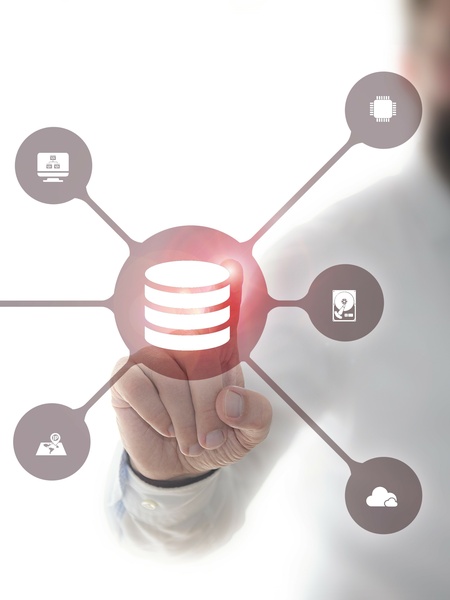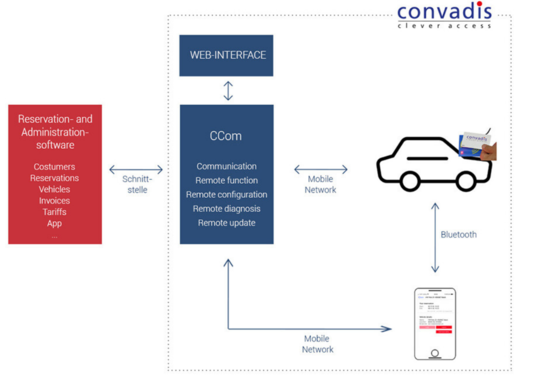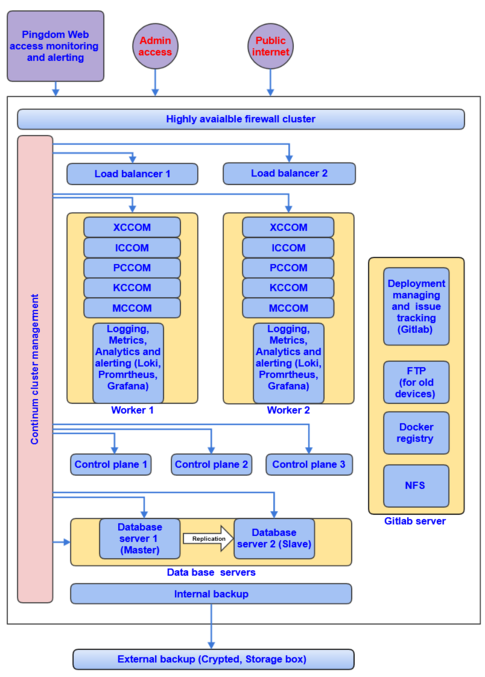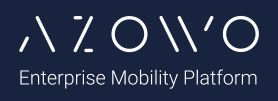Communication server CCom
The core of our fleet management system C-Compact is the server infrastructure as a central communication hub. All information between the booking or fleet management system and the devices in the vehicles is transmitted via the “CCom” communication and administration server. This makes the communication between the vehicles and the booking/fleet management flexible, cost-efficient, and simple.
In addition, CCom is an administration and diagnostic tool with powerful features that simplify processes. The integrated web interface to CCom enables the outsourcing of specialized processes (for experts). Our powerful REST and XML interface allows automation and integration into your platform quickly and easily. In this way, the entire system can be fully adapted, checked, and controlled to your requirements with little effort.
Discover CCom and learn more about why our cost-effective solutions are suitable for all types of carsharing and fleet management systems. For further questions, please do not hesitate to contact us!
Advantages of CCom
Our servers make it easy to manage large fleets, many requests, or different access models. This is ensured by the following features of CCom:
- Variety of functions: Special functions and processes (e.g., remote functions, vehicle setup, vehicle configuration can be done via the CCom web interface, but can also be integrated into the reservation/fleet management system step by step.
- Redundancy: A fully redundant server architecture with a replicated database ensures a high-level of safety.
- Concurrency: Reservation/fleet management systems can be operated in parallel, e.g., a booking platform and an independent vehicle tracking or statistics system.
It is also possible to control several carsharing organizations/ fleets via one single administration platform.
- Strong interface: Owing to the flexible and easy-to-implement API a fast connection to the software platform can be achieved with a minimum of technical effort.
- Secure and cost-efficient data exchange: Data security and encryption are fully handled by our systems. Our systems provide extremely data-saving communication processes to reduce cell phone costs.
- Redundant communication: A high reliability of communication is ensured by redundant processes: the systems provide direct over the air communication capability to the on-board computer systems (TCP/ SMS as a fallback). Additionally, the requesting reservation/access tokens of the user are also transmitted to his/her app (update or screen refresh). The tokens are forwarded to the device in the vehicle when the app connects via Bluetooth, e.g., to unlock the car.
- Reservation storage: The transmission of reservations takes place up to 7 days before the start of the reservation. Up to 99 reservation/access tokens can be stored in our devices to bridge short-term cellular issues.
- Intuitive vehicle management: Fast and easy vehicle management processes via the CCom web interface or directly from the booking/fleet management system (via REST/XML).
- Automatic setup: Automated processes for setting up a new vehicle directly by the installer on site via app, including automatically initiated configuration and firmware uploads (FOTA), no manual intervention in CCom or the back-end system is required.
- Remote configuration: Remote configuration via the web interface (vehicle model settings, firmware areas, provider settings, languages, etc.).
- Integrated configuration templates: Possibility store settings in a template, e.g., different vehicle models, operating modes, etc.
Remote functions (via web interface or reservation/fleet management system)
A variety of different commands can be sent to the vehicles via CCom, e.g., to help users in special situations or request data. Command examples:
Locking and unlocking the vehicle
Immediate access for users with a lost or defective access medium (app, RFID card)
Blocking the immobilizer in case a vehicle is missing
Request GPS position
Update Firmware (FOTA)
All functions are available via the CCom web interface. Many functions can also be integrated into the reservation/fleet management system via API.

Analysis via web interface
Extensive information can be requested via the web interface.
- Vehicle conditions (GPS position, mileage, ignition on/off, fuel/charge level, etc.)
- Communication states of messages from/to the vehicles including detailed information
- Current vehicle usage information (User ID, access media type, usage state, etc.)
- Events (ignition on/off, vehicle login/logout, etc.)
- Alarms (low battery level, car is moved unauthorized, etc.)
- Recorded device logs, including history (memory dump)
- State of the server connectivity (availability, communication channels, etc.)
- And much more
Administration (Web-Interface)
Administrative tasks can be carried out via the web interface. These include for example:
Setup and management of authorized “whitelist” users (RFID cards or app) or granting immediate access to the vehicle without reservation
Setup and management of reservation/fleet management systems, organizations and communication channels
Setup and management of web interface users and their access rights (domains and subdomains, roles, rights in the different views, allowed remote functions, etc.)
Access to integrated document server for exchanging and sharing documents, e.g., installation instructions

With these functions, you have access to the most important information of the vehicle and the usage at any time, can process vehicle configurations remotely, or grant access for users or employees. In addition to the web interface, CCom also supports integrated access via customer-specific reservation and fleet management systems for even more flexibility.
CCom’s server architecture is based on Docker/Kubernetes. The hosting takes place in a high-security data center in Germany, based on a highly available and low-maintenance infrastructure. In the event of a hardware failure the application is automatically restarted on another node. Additionally, an enhanced monitoring and alerting system is implemented.
CCom as an interface to reservation and fleet management systems
With CCom, two different interface types are available for connecting to reservation/fleet management systems. The documentation of the currently provided interfaces can be found here.
XML/Soap Interface
Both types of interfaces can use the following two variants to receive incoming messages from the vehicles:
Push interface / web hook
To use this interface, a HTTPS server is required in the reservation/fleet management system that can receive CCom HTTP POST messages. In CCom, the following values are configurable for accessing the booking system: URL/IP, port, user name, and password.Polling interface (client server)
To use this interface, only a HTTPS client needs to be implemented on the connected system side. A special poll request (HTTP POST) is regularly sent to CCom. Messages to the reservation/fleet management system will be delivered within the response to this request.
Several instances can be connected to CCom in parallel, one push and several polling instances. In addition, two platform instances can be attached to an organization (=fleet).
Authentication and security at CCom
To ensure that no security gaps arise during the authentication of bookings and data exchange in general, we have optimized CCom to the highest data protection standards:
Encrypted communication (CCom - server booking platform): All communication between the connected system and the CCom web interface to our CCom servers is encrypted (HTTPS). All messages are exchanged between CCom and the devices in the vehicles with end-to-end encryption (E2EE/AES-256). The keys between the CCom server and the devices in the vehicles are changed periodically via ECDH (Key Exchange Process). On both end points (CCom and on-board computers) limits against brute force attacks are implemented.
User identification by User ID: Authentication between the CCom server and CApp/CAppLib uses an “app key” that represents an organization and a “User ID” (256 bit). The “User ID” must be randomly generated by the booking system and assigned to a user. The authentication between CApp and the on-board computer takes place via the “User ID”. Authentication between the other interfaces (booking/fleet management system, web interface, push service) is secured by User ID/password and/or via tokens (OAUTH2).
These numerous mechanisms ensure that data is not accessible to unauthorized persons, the system cannot be manipulated and successful authentication is subject to strict procedural requirements with individual assignment and a high-level of encryption.








